Change Management: Theories and Strategies for Organizational Transformation
VerifiedAdded on 2022/11/29
|9
|3579
|419
AI Summary
This document discusses the theories and strategies of change management for organizational transformation. It explores Kotter's 8-step model, force-field analysis, and the process of changing organizational culture. The case study analysis focuses on IBM and provides recommendations for successful change implementation.
Contribute Materials
Your contribution can guide someone’s learning journey. Share your
documents today.
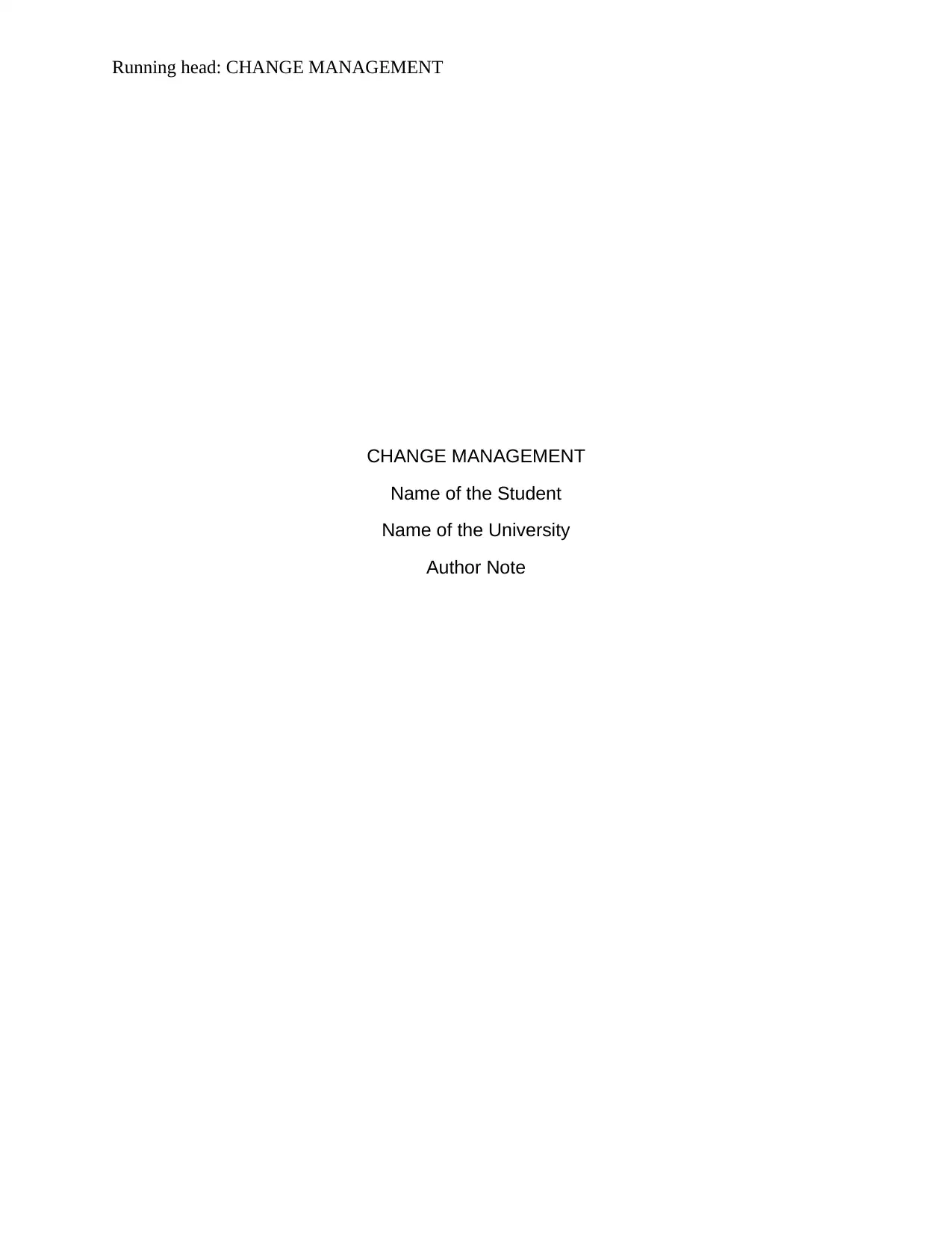
Running head: CHANGE MANAGEMENT
CHANGE MANAGEMENT
Name of the Student
Name of the University
Author Note
CHANGE MANAGEMENT
Name of the Student
Name of the University
Author Note
Secure Best Marks with AI Grader
Need help grading? Try our AI Grader for instant feedback on your assignments.
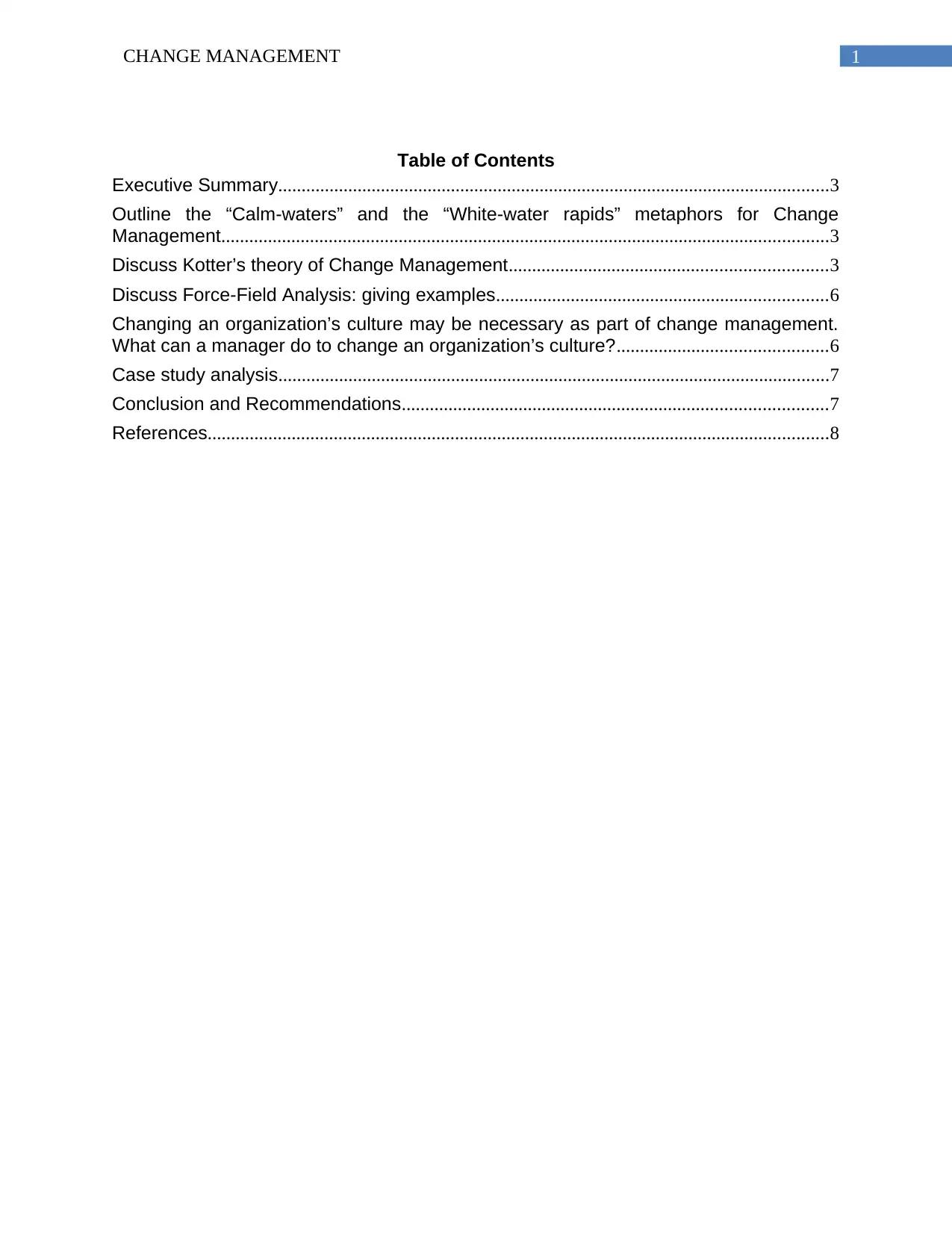
1CHANGE MANAGEMENT
Table of Contents
Executive Summary......................................................................................................................3
Outline the “Calm-waters” and the “White-water rapids” metaphors for Change
Management..................................................................................................................................3
Discuss Kotter’s theory of Change Management....................................................................3
Discuss Force-Field Analysis: giving examples.......................................................................6
Changing an organization’s culture may be necessary as part of change management.
What can a manager do to change an organization’s culture?.............................................6
Case study analysis......................................................................................................................7
Conclusion and Recommendations...........................................................................................7
References.....................................................................................................................................8
Table of Contents
Executive Summary......................................................................................................................3
Outline the “Calm-waters” and the “White-water rapids” metaphors for Change
Management..................................................................................................................................3
Discuss Kotter’s theory of Change Management....................................................................3
Discuss Force-Field Analysis: giving examples.......................................................................6
Changing an organization’s culture may be necessary as part of change management.
What can a manager do to change an organization’s culture?.............................................6
Case study analysis......................................................................................................................7
Conclusion and Recommendations...........................................................................................7
References.....................................................................................................................................8
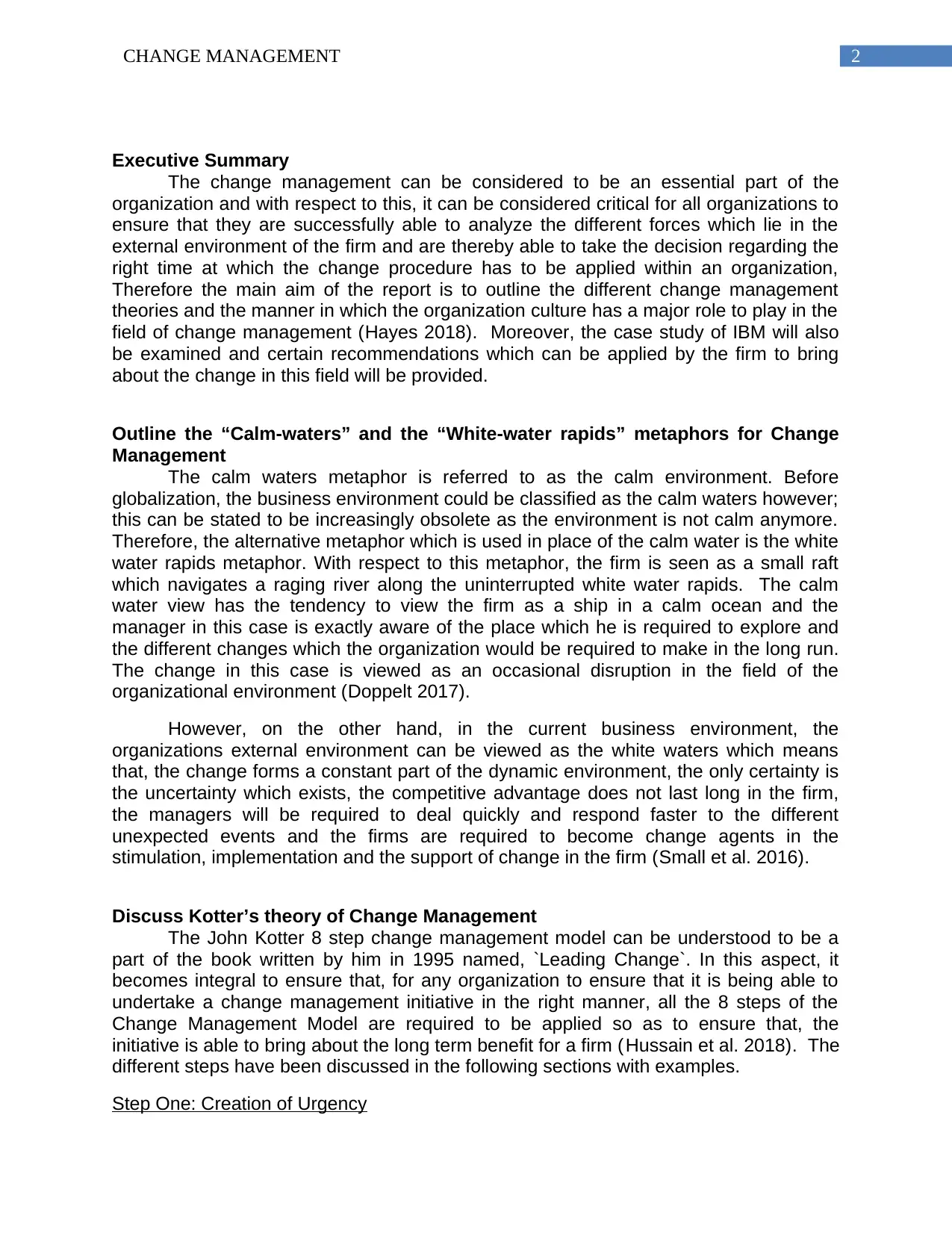
2CHANGE MANAGEMENT
Executive Summary
The change management can be considered to be an essential part of the
organization and with respect to this, it can be considered critical for all organizations to
ensure that they are successfully able to analyze the different forces which lie in the
external environment of the firm and are thereby able to take the decision regarding the
right time at which the change procedure has to be applied within an organization,
Therefore the main aim of the report is to outline the different change management
theories and the manner in which the organization culture has a major role to play in the
field of change management (Hayes 2018). Moreover, the case study of IBM will also
be examined and certain recommendations which can be applied by the firm to bring
about the change in this field will be provided.
Outline the “Calm-waters” and the “White-water rapids” metaphors for Change
Management
The calm waters metaphor is referred to as the calm environment. Before
globalization, the business environment could be classified as the calm waters however;
this can be stated to be increasingly obsolete as the environment is not calm anymore.
Therefore, the alternative metaphor which is used in place of the calm water is the white
water rapids metaphor. With respect to this metaphor, the firm is seen as a small raft
which navigates a raging river along the uninterrupted white water rapids. The calm
water view has the tendency to view the firm as a ship in a calm ocean and the
manager in this case is exactly aware of the place which he is required to explore and
the different changes which the organization would be required to make in the long run.
The change in this case is viewed as an occasional disruption in the field of the
organizational environment (Doppelt 2017).
However, on the other hand, in the current business environment, the
organizations external environment can be viewed as the white waters which means
that, the change forms a constant part of the dynamic environment, the only certainty is
the uncertainty which exists, the competitive advantage does not last long in the firm,
the managers will be required to deal quickly and respond faster to the different
unexpected events and the firms are required to become change agents in the
stimulation, implementation and the support of change in the firm (Small et al. 2016).
Discuss Kotter’s theory of Change Management
The John Kotter 8 step change management model can be understood to be a
part of the book written by him in 1995 named, `Leading Change`. In this aspect, it
becomes integral to ensure that, for any organization to ensure that it is being able to
undertake a change management initiative in the right manner, all the 8 steps of the
Change Management Model are required to be applied so as to ensure that, the
initiative is able to bring about the long term benefit for a firm (Hussain et al. 2018). The
different steps have been discussed in the following sections with examples.
Step One: Creation of Urgency
Executive Summary
The change management can be considered to be an essential part of the
organization and with respect to this, it can be considered critical for all organizations to
ensure that they are successfully able to analyze the different forces which lie in the
external environment of the firm and are thereby able to take the decision regarding the
right time at which the change procedure has to be applied within an organization,
Therefore the main aim of the report is to outline the different change management
theories and the manner in which the organization culture has a major role to play in the
field of change management (Hayes 2018). Moreover, the case study of IBM will also
be examined and certain recommendations which can be applied by the firm to bring
about the change in this field will be provided.
Outline the “Calm-waters” and the “White-water rapids” metaphors for Change
Management
The calm waters metaphor is referred to as the calm environment. Before
globalization, the business environment could be classified as the calm waters however;
this can be stated to be increasingly obsolete as the environment is not calm anymore.
Therefore, the alternative metaphor which is used in place of the calm water is the white
water rapids metaphor. With respect to this metaphor, the firm is seen as a small raft
which navigates a raging river along the uninterrupted white water rapids. The calm
water view has the tendency to view the firm as a ship in a calm ocean and the
manager in this case is exactly aware of the place which he is required to explore and
the different changes which the organization would be required to make in the long run.
The change in this case is viewed as an occasional disruption in the field of the
organizational environment (Doppelt 2017).
However, on the other hand, in the current business environment, the
organizations external environment can be viewed as the white waters which means
that, the change forms a constant part of the dynamic environment, the only certainty is
the uncertainty which exists, the competitive advantage does not last long in the firm,
the managers will be required to deal quickly and respond faster to the different
unexpected events and the firms are required to become change agents in the
stimulation, implementation and the support of change in the firm (Small et al. 2016).
Discuss Kotter’s theory of Change Management
The John Kotter 8 step change management model can be understood to be a
part of the book written by him in 1995 named, `Leading Change`. In this aspect, it
becomes integral to ensure that, for any organization to ensure that it is being able to
undertake a change management initiative in the right manner, all the 8 steps of the
Change Management Model are required to be applied so as to ensure that, the
initiative is able to bring about the long term benefit for a firm (Hussain et al. 2018). The
different steps have been discussed in the following sections with examples.
Step One: Creation of Urgency
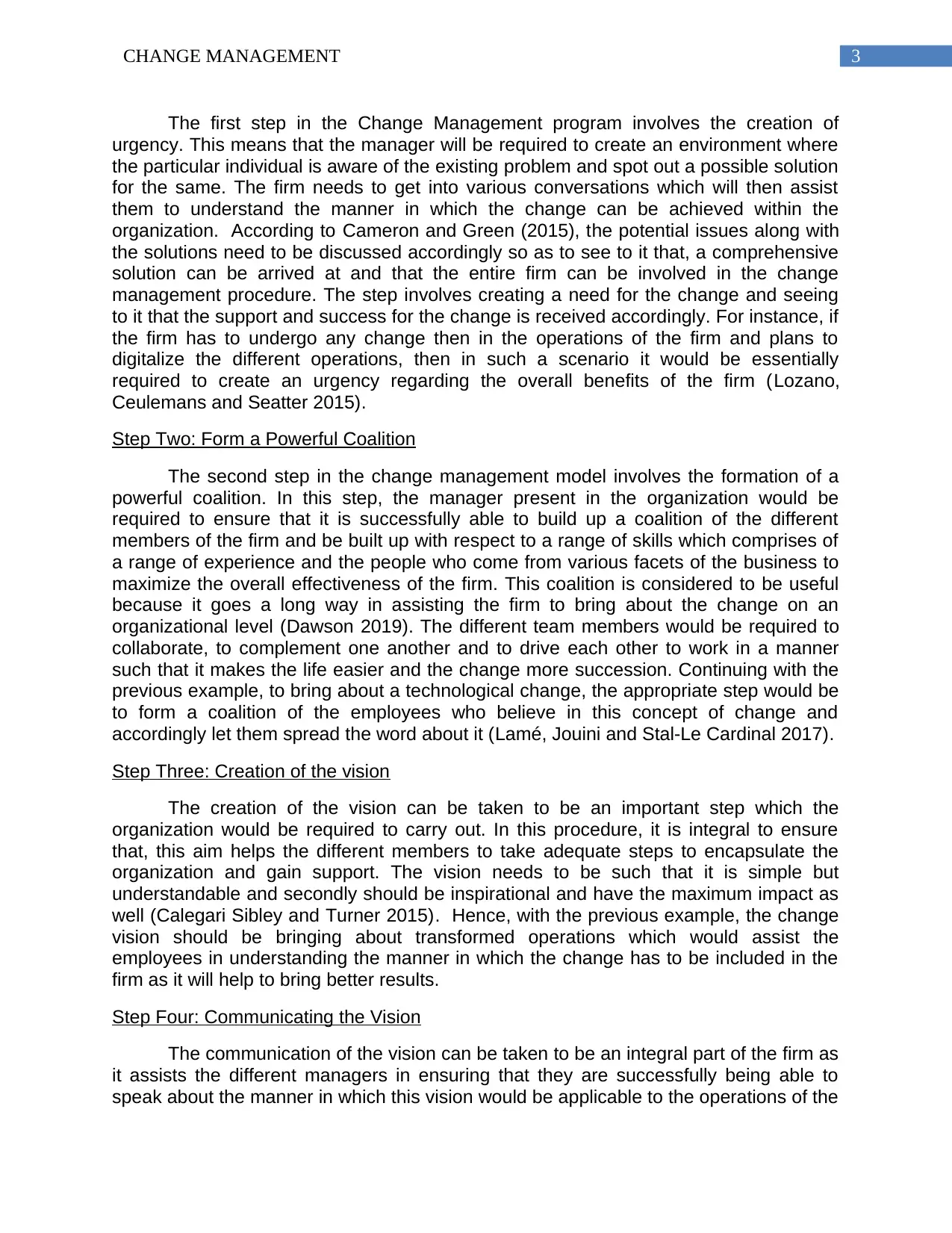
3CHANGE MANAGEMENT
The first step in the Change Management program involves the creation of
urgency. This means that the manager will be required to create an environment where
the particular individual is aware of the existing problem and spot out a possible solution
for the same. The firm needs to get into various conversations which will then assist
them to understand the manner in which the change can be achieved within the
organization. According to Cameron and Green (2015), the potential issues along with
the solutions need to be discussed accordingly so as to see to it that, a comprehensive
solution can be arrived at and that the entire firm can be involved in the change
management procedure. The step involves creating a need for the change and seeing
to it that the support and success for the change is received accordingly. For instance, if
the firm has to undergo any change then in the operations of the firm and plans to
digitalize the different operations, then in such a scenario it would be essentially
required to create an urgency regarding the overall benefits of the firm (Lozano,
Ceulemans and Seatter 2015).
Step Two: Form a Powerful Coalition
The second step in the change management model involves the formation of a
powerful coalition. In this step, the manager present in the organization would be
required to ensure that it is successfully able to build up a coalition of the different
members of the firm and be built up with respect to a range of skills which comprises of
a range of experience and the people who come from various facets of the business to
maximize the overall effectiveness of the firm. This coalition is considered to be useful
because it goes a long way in assisting the firm to bring about the change on an
organizational level (Dawson 2019). The different team members would be required to
collaborate, to complement one another and to drive each other to work in a manner
such that it makes the life easier and the change more succession. Continuing with the
previous example, to bring about a technological change, the appropriate step would be
to form a coalition of the employees who believe in this concept of change and
accordingly let them spread the word about it (Lamé, Jouini and Stal-Le Cardinal 2017).
Step Three: Creation of the vision
The creation of the vision can be taken to be an important step which the
organization would be required to carry out. In this procedure, it is integral to ensure
that, this aim helps the different members to take adequate steps to encapsulate the
organization and gain support. The vision needs to be such that it is simple but
understandable and secondly should be inspirational and have the maximum impact as
well (Calegari Sibley and Turner 2015). Hence, with the previous example, the change
vision should be bringing about transformed operations which would assist the
employees in understanding the manner in which the change has to be included in the
firm as it will help to bring better results.
Step Four: Communicating the Vision
The communication of the vision can be taken to be an integral part of the firm as
it assists the different managers in ensuring that they are successfully being able to
speak about the manner in which this vision would be applicable to the operations of the
The first step in the Change Management program involves the creation of
urgency. This means that the manager will be required to create an environment where
the particular individual is aware of the existing problem and spot out a possible solution
for the same. The firm needs to get into various conversations which will then assist
them to understand the manner in which the change can be achieved within the
organization. According to Cameron and Green (2015), the potential issues along with
the solutions need to be discussed accordingly so as to see to it that, a comprehensive
solution can be arrived at and that the entire firm can be involved in the change
management procedure. The step involves creating a need for the change and seeing
to it that the support and success for the change is received accordingly. For instance, if
the firm has to undergo any change then in the operations of the firm and plans to
digitalize the different operations, then in such a scenario it would be essentially
required to create an urgency regarding the overall benefits of the firm (Lozano,
Ceulemans and Seatter 2015).
Step Two: Form a Powerful Coalition
The second step in the change management model involves the formation of a
powerful coalition. In this step, the manager present in the organization would be
required to ensure that it is successfully able to build up a coalition of the different
members of the firm and be built up with respect to a range of skills which comprises of
a range of experience and the people who come from various facets of the business to
maximize the overall effectiveness of the firm. This coalition is considered to be useful
because it goes a long way in assisting the firm to bring about the change on an
organizational level (Dawson 2019). The different team members would be required to
collaborate, to complement one another and to drive each other to work in a manner
such that it makes the life easier and the change more succession. Continuing with the
previous example, to bring about a technological change, the appropriate step would be
to form a coalition of the employees who believe in this concept of change and
accordingly let them spread the word about it (Lamé, Jouini and Stal-Le Cardinal 2017).
Step Three: Creation of the vision
The creation of the vision can be taken to be an important step which the
organization would be required to carry out. In this procedure, it is integral to ensure
that, this aim helps the different members to take adequate steps to encapsulate the
organization and gain support. The vision needs to be such that it is simple but
understandable and secondly should be inspirational and have the maximum impact as
well (Calegari Sibley and Turner 2015). Hence, with the previous example, the change
vision should be bringing about transformed operations which would assist the
employees in understanding the manner in which the change has to be included in the
firm as it will help to bring better results.
Step Four: Communicating the Vision
The communication of the vision can be taken to be an integral part of the firm as
it assists the different managers in ensuring that they are successfully being able to
speak about the manner in which this vision would be applicable to the operations of the
Secure Best Marks with AI Grader
Need help grading? Try our AI Grader for instant feedback on your assignments.
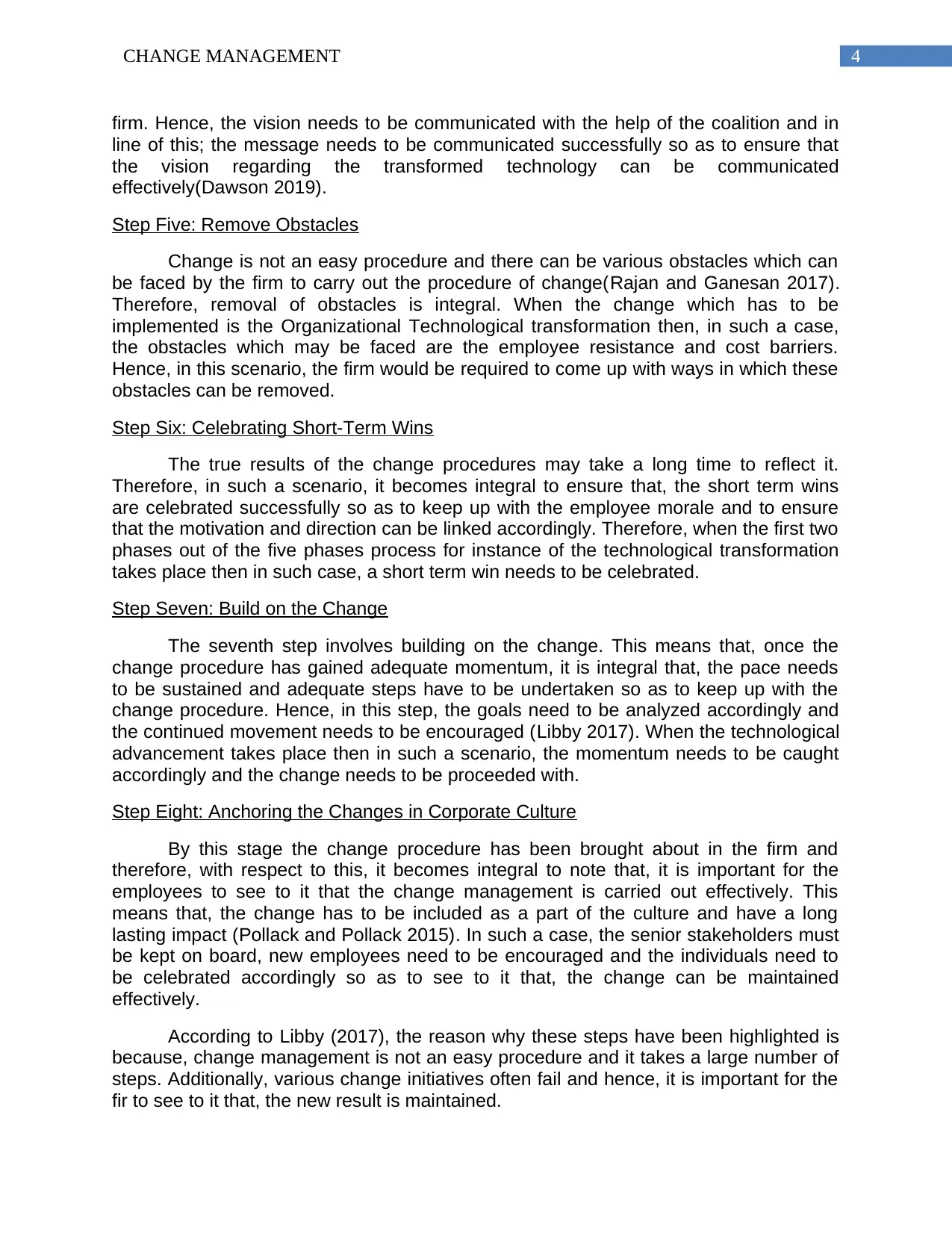
4CHANGE MANAGEMENT
firm. Hence, the vision needs to be communicated with the help of the coalition and in
line of this; the message needs to be communicated successfully so as to ensure that
the vision regarding the transformed technology can be communicated
effectively(Dawson 2019).
Step Five: Remove Obstacles
Change is not an easy procedure and there can be various obstacles which can
be faced by the firm to carry out the procedure of change(Rajan and Ganesan 2017).
Therefore, removal of obstacles is integral. When the change which has to be
implemented is the Organizational Technological transformation then, in such a case,
the obstacles which may be faced are the employee resistance and cost barriers.
Hence, in this scenario, the firm would be required to come up with ways in which these
obstacles can be removed.
Step Six: Celebrating Short-Term Wins
The true results of the change procedures may take a long time to reflect it.
Therefore, in such a scenario, it becomes integral to ensure that, the short term wins
are celebrated successfully so as to keep up with the employee morale and to ensure
that the motivation and direction can be linked accordingly. Therefore, when the first two
phases out of the five phases process for instance of the technological transformation
takes place then in such case, a short term win needs to be celebrated.
Step Seven: Build on the Change
The seventh step involves building on the change. This means that, once the
change procedure has gained adequate momentum, it is integral that, the pace needs
to be sustained and adequate steps have to be undertaken so as to keep up with the
change procedure. Hence, in this step, the goals need to be analyzed accordingly and
the continued movement needs to be encouraged (Libby 2017). When the technological
advancement takes place then in such a scenario, the momentum needs to be caught
accordingly and the change needs to be proceeded with.
Step Eight: Anchoring the Changes in Corporate Culture
By this stage the change procedure has been brought about in the firm and
therefore, with respect to this, it becomes integral to note that, it is important for the
employees to see to it that the change management is carried out effectively. This
means that, the change has to be included as a part of the culture and have a long
lasting impact (Pollack and Pollack 2015). In such a case, the senior stakeholders must
be kept on board, new employees need to be encouraged and the individuals need to
be celebrated accordingly so as to see to it that, the change can be maintained
effectively.
According to Libby (2017), the reason why these steps have been highlighted is
because, change management is not an easy procedure and it takes a large number of
steps. Additionally, various change initiatives often fail and hence, it is important for the
fir to see to it that, the new result is maintained.
firm. Hence, the vision needs to be communicated with the help of the coalition and in
line of this; the message needs to be communicated successfully so as to ensure that
the vision regarding the transformed technology can be communicated
effectively(Dawson 2019).
Step Five: Remove Obstacles
Change is not an easy procedure and there can be various obstacles which can
be faced by the firm to carry out the procedure of change(Rajan and Ganesan 2017).
Therefore, removal of obstacles is integral. When the change which has to be
implemented is the Organizational Technological transformation then, in such a case,
the obstacles which may be faced are the employee resistance and cost barriers.
Hence, in this scenario, the firm would be required to come up with ways in which these
obstacles can be removed.
Step Six: Celebrating Short-Term Wins
The true results of the change procedures may take a long time to reflect it.
Therefore, in such a scenario, it becomes integral to ensure that, the short term wins
are celebrated successfully so as to keep up with the employee morale and to ensure
that the motivation and direction can be linked accordingly. Therefore, when the first two
phases out of the five phases process for instance of the technological transformation
takes place then in such case, a short term win needs to be celebrated.
Step Seven: Build on the Change
The seventh step involves building on the change. This means that, once the
change procedure has gained adequate momentum, it is integral that, the pace needs
to be sustained and adequate steps have to be undertaken so as to keep up with the
change procedure. Hence, in this step, the goals need to be analyzed accordingly and
the continued movement needs to be encouraged (Libby 2017). When the technological
advancement takes place then in such a scenario, the momentum needs to be caught
accordingly and the change needs to be proceeded with.
Step Eight: Anchoring the Changes in Corporate Culture
By this stage the change procedure has been brought about in the firm and
therefore, with respect to this, it becomes integral to note that, it is important for the
employees to see to it that the change management is carried out effectively. This
means that, the change has to be included as a part of the culture and have a long
lasting impact (Pollack and Pollack 2015). In such a case, the senior stakeholders must
be kept on board, new employees need to be encouraged and the individuals need to
be celebrated accordingly so as to see to it that, the change can be maintained
effectively.
According to Libby (2017), the reason why these steps have been highlighted is
because, change management is not an easy procedure and it takes a large number of
steps. Additionally, various change initiatives often fail and hence, it is important for the
fir to see to it that, the new result is maintained.
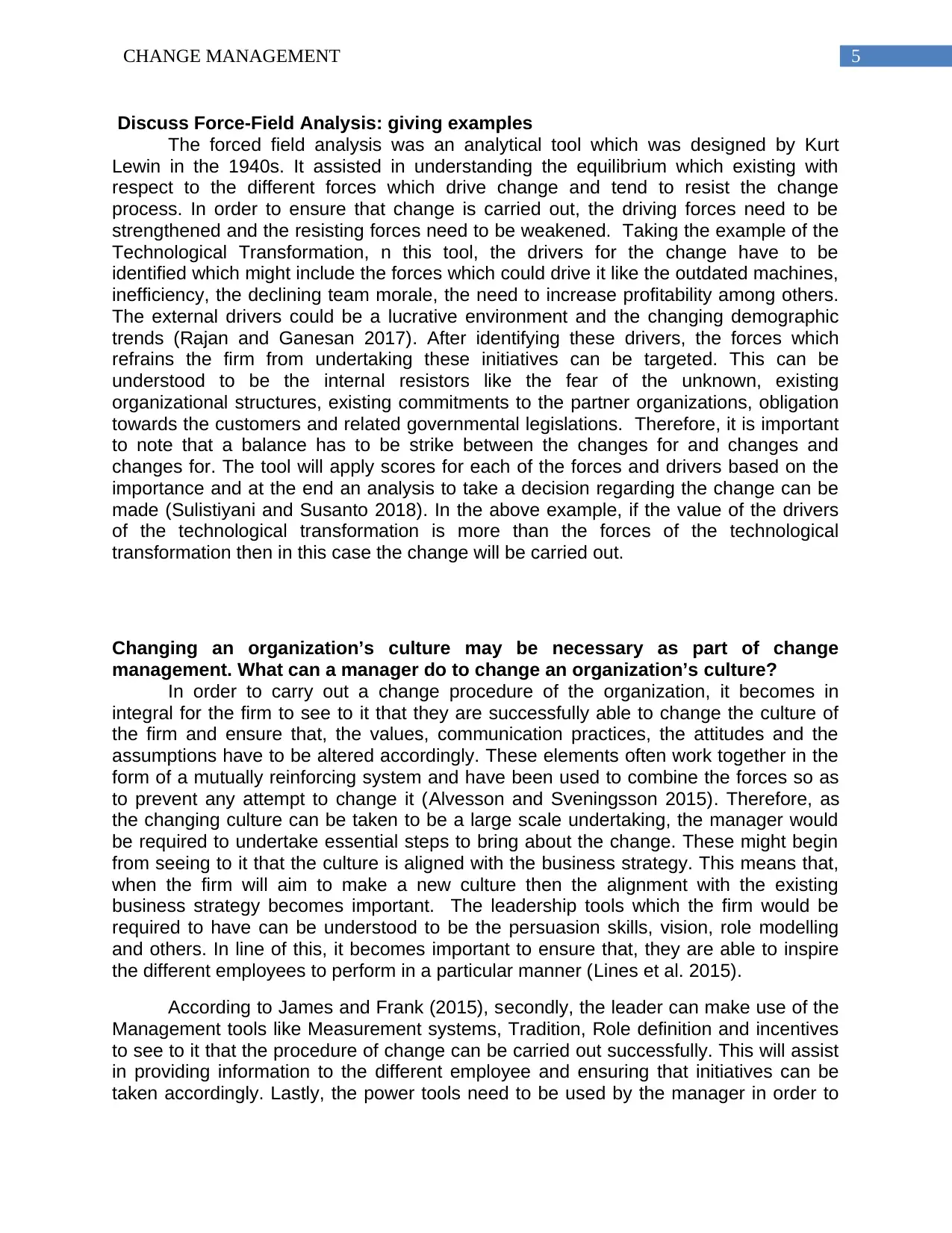
5CHANGE MANAGEMENT
Discuss Force-Field Analysis: giving examples
The forced field analysis was an analytical tool which was designed by Kurt
Lewin in the 1940s. It assisted in understanding the equilibrium which existing with
respect to the different forces which drive change and tend to resist the change
process. In order to ensure that change is carried out, the driving forces need to be
strengthened and the resisting forces need to be weakened. Taking the example of the
Technological Transformation, n this tool, the drivers for the change have to be
identified which might include the forces which could drive it like the outdated machines,
inefficiency, the declining team morale, the need to increase profitability among others.
The external drivers could be a lucrative environment and the changing demographic
trends (Rajan and Ganesan 2017). After identifying these drivers, the forces which
refrains the firm from undertaking these initiatives can be targeted. This can be
understood to be the internal resistors like the fear of the unknown, existing
organizational structures, existing commitments to the partner organizations, obligation
towards the customers and related governmental legislations. Therefore, it is important
to note that a balance has to be strike between the changes for and changes and
changes for. The tool will apply scores for each of the forces and drivers based on the
importance and at the end an analysis to take a decision regarding the change can be
made (Sulistiyani and Susanto 2018). In the above example, if the value of the drivers
of the technological transformation is more than the forces of the technological
transformation then in this case the change will be carried out.
Changing an organization’s culture may be necessary as part of change
management. What can a manager do to change an organization’s culture?
In order to carry out a change procedure of the organization, it becomes in
integral for the firm to see to it that they are successfully able to change the culture of
the firm and ensure that, the values, communication practices, the attitudes and the
assumptions have to be altered accordingly. These elements often work together in the
form of a mutually reinforcing system and have been used to combine the forces so as
to prevent any attempt to change it (Alvesson and Sveningsson 2015). Therefore, as
the changing culture can be taken to be a large scale undertaking, the manager would
be required to undertake essential steps to bring about the change. These might begin
from seeing to it that the culture is aligned with the business strategy. This means that,
when the firm will aim to make a new culture then the alignment with the existing
business strategy becomes important. The leadership tools which the firm would be
required to have can be understood to be the persuasion skills, vision, role modelling
and others. In line of this, it becomes important to ensure that, they are able to inspire
the different employees to perform in a particular manner (Lines et al. 2015).
According to James and Frank (2015), secondly, the leader can make use of the
Management tools like Measurement systems, Tradition, Role definition and incentives
to see to it that the procedure of change can be carried out successfully. This will assist
in providing information to the different employee and ensuring that initiatives can be
taken accordingly. Lastly, the power tools need to be used by the manager in order to
Discuss Force-Field Analysis: giving examples
The forced field analysis was an analytical tool which was designed by Kurt
Lewin in the 1940s. It assisted in understanding the equilibrium which existing with
respect to the different forces which drive change and tend to resist the change
process. In order to ensure that change is carried out, the driving forces need to be
strengthened and the resisting forces need to be weakened. Taking the example of the
Technological Transformation, n this tool, the drivers for the change have to be
identified which might include the forces which could drive it like the outdated machines,
inefficiency, the declining team morale, the need to increase profitability among others.
The external drivers could be a lucrative environment and the changing demographic
trends (Rajan and Ganesan 2017). After identifying these drivers, the forces which
refrains the firm from undertaking these initiatives can be targeted. This can be
understood to be the internal resistors like the fear of the unknown, existing
organizational structures, existing commitments to the partner organizations, obligation
towards the customers and related governmental legislations. Therefore, it is important
to note that a balance has to be strike between the changes for and changes and
changes for. The tool will apply scores for each of the forces and drivers based on the
importance and at the end an analysis to take a decision regarding the change can be
made (Sulistiyani and Susanto 2018). In the above example, if the value of the drivers
of the technological transformation is more than the forces of the technological
transformation then in this case the change will be carried out.
Changing an organization’s culture may be necessary as part of change
management. What can a manager do to change an organization’s culture?
In order to carry out a change procedure of the organization, it becomes in
integral for the firm to see to it that they are successfully able to change the culture of
the firm and ensure that, the values, communication practices, the attitudes and the
assumptions have to be altered accordingly. These elements often work together in the
form of a mutually reinforcing system and have been used to combine the forces so as
to prevent any attempt to change it (Alvesson and Sveningsson 2015). Therefore, as
the changing culture can be taken to be a large scale undertaking, the manager would
be required to undertake essential steps to bring about the change. These might begin
from seeing to it that the culture is aligned with the business strategy. This means that,
when the firm will aim to make a new culture then the alignment with the existing
business strategy becomes important. The leadership tools which the firm would be
required to have can be understood to be the persuasion skills, vision, role modelling
and others. In line of this, it becomes important to ensure that, they are able to inspire
the different employees to perform in a particular manner (Lines et al. 2015).
According to James and Frank (2015), secondly, the leader can make use of the
Management tools like Measurement systems, Tradition, Role definition and incentives
to see to it that the procedure of change can be carried out successfully. This will assist
in providing information to the different employee and ensuring that initiatives can be
taken accordingly. Lastly, the power tools need to be used by the manager in order to
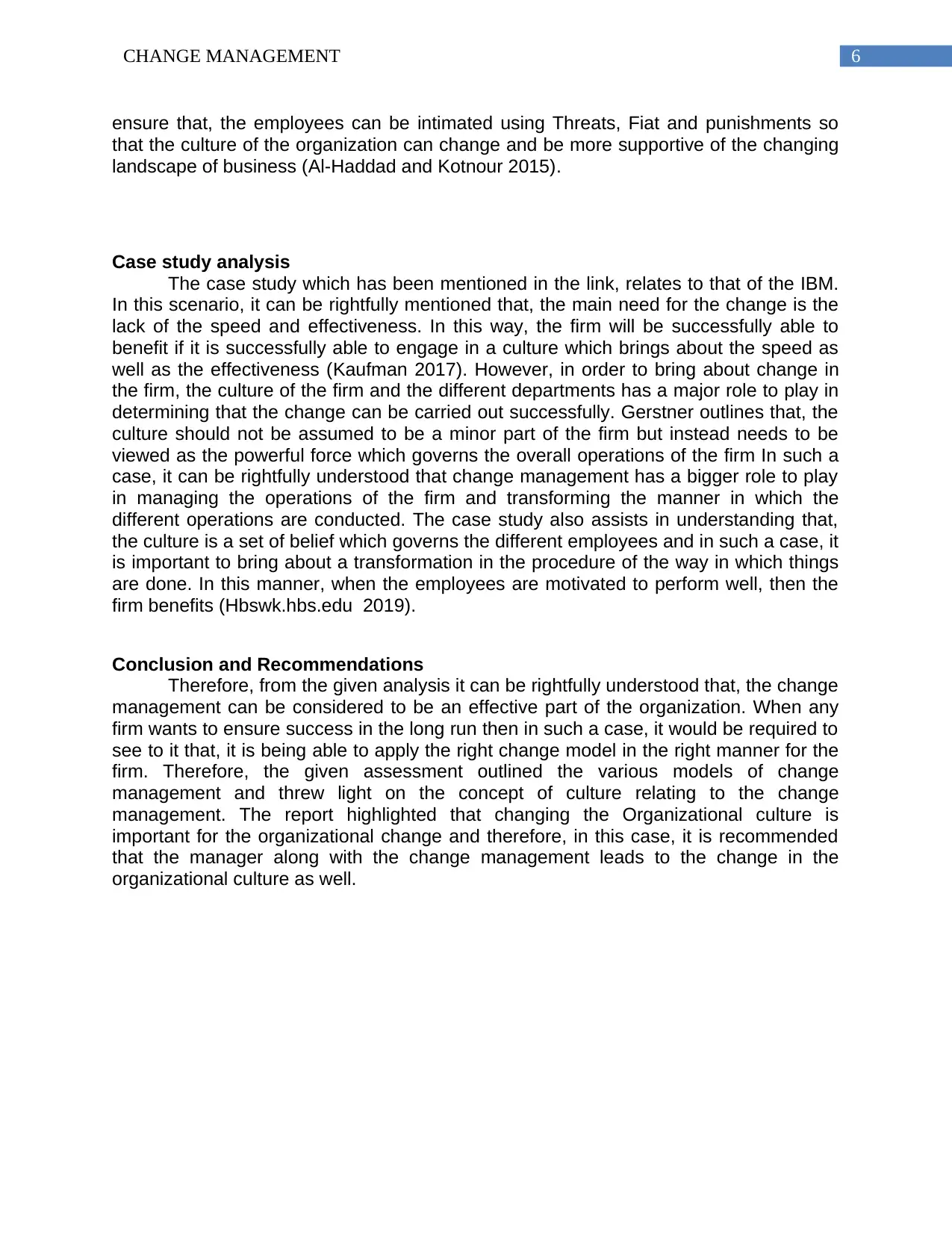
6CHANGE MANAGEMENT
ensure that, the employees can be intimated using Threats, Fiat and punishments so
that the culture of the organization can change and be more supportive of the changing
landscape of business (Al-Haddad and Kotnour 2015).
Case study analysis
The case study which has been mentioned in the link, relates to that of the IBM.
In this scenario, it can be rightfully mentioned that, the main need for the change is the
lack of the speed and effectiveness. In this way, the firm will be successfully able to
benefit if it is successfully able to engage in a culture which brings about the speed as
well as the effectiveness (Kaufman 2017). However, in order to bring about change in
the firm, the culture of the firm and the different departments has a major role to play in
determining that the change can be carried out successfully. Gerstner outlines that, the
culture should not be assumed to be a minor part of the firm but instead needs to be
viewed as the powerful force which governs the overall operations of the firm In such a
case, it can be rightfully understood that change management has a bigger role to play
in managing the operations of the firm and transforming the manner in which the
different operations are conducted. The case study also assists in understanding that,
the culture is a set of belief which governs the different employees and in such a case, it
is important to bring about a transformation in the procedure of the way in which things
are done. In this manner, when the employees are motivated to perform well, then the
firm benefits (Hbswk.hbs.edu 2019).
Conclusion and Recommendations
Therefore, from the given analysis it can be rightfully understood that, the change
management can be considered to be an effective part of the organization. When any
firm wants to ensure success in the long run then in such a case, it would be required to
see to it that, it is being able to apply the right change model in the right manner for the
firm. Therefore, the given assessment outlined the various models of change
management and threw light on the concept of culture relating to the change
management. The report highlighted that changing the Organizational culture is
important for the organizational change and therefore, in this case, it is recommended
that the manager along with the change management leads to the change in the
organizational culture as well.
ensure that, the employees can be intimated using Threats, Fiat and punishments so
that the culture of the organization can change and be more supportive of the changing
landscape of business (Al-Haddad and Kotnour 2015).
Case study analysis
The case study which has been mentioned in the link, relates to that of the IBM.
In this scenario, it can be rightfully mentioned that, the main need for the change is the
lack of the speed and effectiveness. In this way, the firm will be successfully able to
benefit if it is successfully able to engage in a culture which brings about the speed as
well as the effectiveness (Kaufman 2017). However, in order to bring about change in
the firm, the culture of the firm and the different departments has a major role to play in
determining that the change can be carried out successfully. Gerstner outlines that, the
culture should not be assumed to be a minor part of the firm but instead needs to be
viewed as the powerful force which governs the overall operations of the firm In such a
case, it can be rightfully understood that change management has a bigger role to play
in managing the operations of the firm and transforming the manner in which the
different operations are conducted. The case study also assists in understanding that,
the culture is a set of belief which governs the different employees and in such a case, it
is important to bring about a transformation in the procedure of the way in which things
are done. In this manner, when the employees are motivated to perform well, then the
firm benefits (Hbswk.hbs.edu 2019).
Conclusion and Recommendations
Therefore, from the given analysis it can be rightfully understood that, the change
management can be considered to be an effective part of the organization. When any
firm wants to ensure success in the long run then in such a case, it would be required to
see to it that, it is being able to apply the right change model in the right manner for the
firm. Therefore, the given assessment outlined the various models of change
management and threw light on the concept of culture relating to the change
management. The report highlighted that changing the Organizational culture is
important for the organizational change and therefore, in this case, it is recommended
that the manager along with the change management leads to the change in the
organizational culture as well.
Paraphrase This Document
Need a fresh take? Get an instant paraphrase of this document with our AI Paraphraser
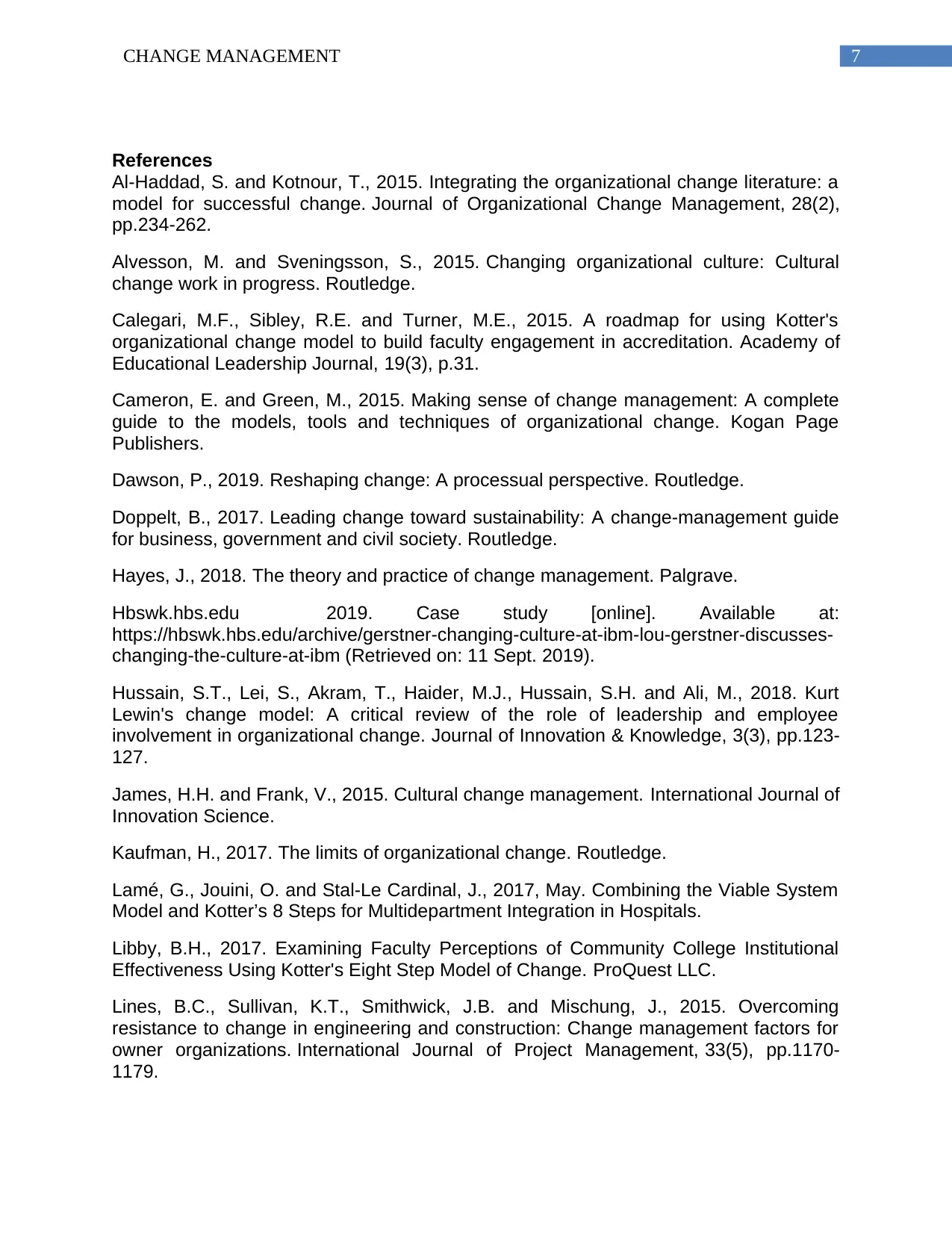
7CHANGE MANAGEMENT
References
Al-Haddad, S. and Kotnour, T., 2015. Integrating the organizational change literature: a
model for successful change. Journal of Organizational Change Management, 28(2),
pp.234-262.
Alvesson, M. and Sveningsson, S., 2015. Changing organizational culture: Cultural
change work in progress. Routledge.
Calegari, M.F., Sibley, R.E. and Turner, M.E., 2015. A roadmap for using Kotter's
organizational change model to build faculty engagement in accreditation. Academy of
Educational Leadership Journal, 19(3), p.31.
Cameron, E. and Green, M., 2015. Making sense of change management: A complete
guide to the models, tools and techniques of organizational change. Kogan Page
Publishers.
Dawson, P., 2019. Reshaping change: A processual perspective. Routledge.
Doppelt, B., 2017. Leading change toward sustainability: A change-management guide
for business, government and civil society. Routledge.
Hayes, J., 2018. The theory and practice of change management. Palgrave.
Hbswk.hbs.edu 2019. Case study [online]. Available at:
https://hbswk.hbs.edu/archive/gerstner-changing-culture-at-ibm-lou-gerstner-discusses-
changing-the-culture-at-ibm (Retrieved on: 11 Sept. 2019).
Hussain, S.T., Lei, S., Akram, T., Haider, M.J., Hussain, S.H. and Ali, M., 2018. Kurt
Lewin's change model: A critical review of the role of leadership and employee
involvement in organizational change. Journal of Innovation & Knowledge, 3(3), pp.123-
127.
James, H.H. and Frank, V., 2015. Cultural change management. International Journal of
Innovation Science.
Kaufman, H., 2017. The limits of organizational change. Routledge.
Lamé, G., Jouini, O. and Stal-Le Cardinal, J., 2017, May. Combining the Viable System
Model and Kotter’s 8 Steps for Multidepartment Integration in Hospitals.
Libby, B.H., 2017. Examining Faculty Perceptions of Community College Institutional
Effectiveness Using Kotter's Eight Step Model of Change. ProQuest LLC.
Lines, B.C., Sullivan, K.T., Smithwick, J.B. and Mischung, J., 2015. Overcoming
resistance to change in engineering and construction: Change management factors for
owner organizations. International Journal of Project Management, 33(5), pp.1170-
1179.
References
Al-Haddad, S. and Kotnour, T., 2015. Integrating the organizational change literature: a
model for successful change. Journal of Organizational Change Management, 28(2),
pp.234-262.
Alvesson, M. and Sveningsson, S., 2015. Changing organizational culture: Cultural
change work in progress. Routledge.
Calegari, M.F., Sibley, R.E. and Turner, M.E., 2015. A roadmap for using Kotter's
organizational change model to build faculty engagement in accreditation. Academy of
Educational Leadership Journal, 19(3), p.31.
Cameron, E. and Green, M., 2015. Making sense of change management: A complete
guide to the models, tools and techniques of organizational change. Kogan Page
Publishers.
Dawson, P., 2019. Reshaping change: A processual perspective. Routledge.
Doppelt, B., 2017. Leading change toward sustainability: A change-management guide
for business, government and civil society. Routledge.
Hayes, J., 2018. The theory and practice of change management. Palgrave.
Hbswk.hbs.edu 2019. Case study [online]. Available at:
https://hbswk.hbs.edu/archive/gerstner-changing-culture-at-ibm-lou-gerstner-discusses-
changing-the-culture-at-ibm (Retrieved on: 11 Sept. 2019).
Hussain, S.T., Lei, S., Akram, T., Haider, M.J., Hussain, S.H. and Ali, M., 2018. Kurt
Lewin's change model: A critical review of the role of leadership and employee
involvement in organizational change. Journal of Innovation & Knowledge, 3(3), pp.123-
127.
James, H.H. and Frank, V., 2015. Cultural change management. International Journal of
Innovation Science.
Kaufman, H., 2017. The limits of organizational change. Routledge.
Lamé, G., Jouini, O. and Stal-Le Cardinal, J., 2017, May. Combining the Viable System
Model and Kotter’s 8 Steps for Multidepartment Integration in Hospitals.
Libby, B.H., 2017. Examining Faculty Perceptions of Community College Institutional
Effectiveness Using Kotter's Eight Step Model of Change. ProQuest LLC.
Lines, B.C., Sullivan, K.T., Smithwick, J.B. and Mischung, J., 2015. Overcoming
resistance to change in engineering and construction: Change management factors for
owner organizations. International Journal of Project Management, 33(5), pp.1170-
1179.
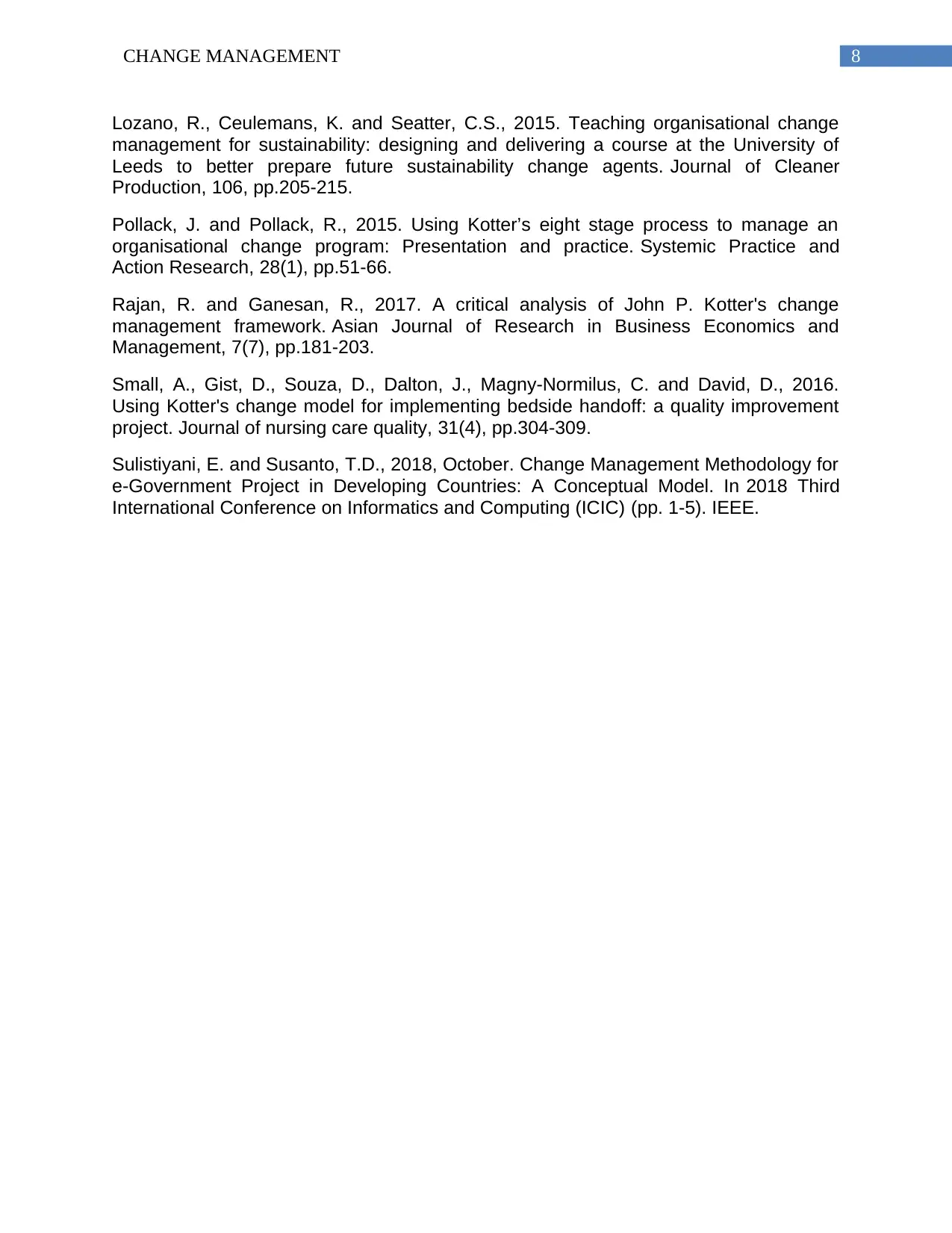
8CHANGE MANAGEMENT
Lozano, R., Ceulemans, K. and Seatter, C.S., 2015. Teaching organisational change
management for sustainability: designing and delivering a course at the University of
Leeds to better prepare future sustainability change agents. Journal of Cleaner
Production, 106, pp.205-215.
Pollack, J. and Pollack, R., 2015. Using Kotter’s eight stage process to manage an
organisational change program: Presentation and practice. Systemic Practice and
Action Research, 28(1), pp.51-66.
Rajan, R. and Ganesan, R., 2017. A critical analysis of John P. Kotter's change
management framework. Asian Journal of Research in Business Economics and
Management, 7(7), pp.181-203.
Small, A., Gist, D., Souza, D., Dalton, J., Magny-Normilus, C. and David, D., 2016.
Using Kotter's change model for implementing bedside handoff: a quality improvement
project. Journal of nursing care quality, 31(4), pp.304-309.
Sulistiyani, E. and Susanto, T.D., 2018, October. Change Management Methodology for
e-Government Project in Developing Countries: A Conceptual Model. In 2018 Third
International Conference on Informatics and Computing (ICIC) (pp. 1-5). IEEE.
Lozano, R., Ceulemans, K. and Seatter, C.S., 2015. Teaching organisational change
management for sustainability: designing and delivering a course at the University of
Leeds to better prepare future sustainability change agents. Journal of Cleaner
Production, 106, pp.205-215.
Pollack, J. and Pollack, R., 2015. Using Kotter’s eight stage process to manage an
organisational change program: Presentation and practice. Systemic Practice and
Action Research, 28(1), pp.51-66.
Rajan, R. and Ganesan, R., 2017. A critical analysis of John P. Kotter's change
management framework. Asian Journal of Research in Business Economics and
Management, 7(7), pp.181-203.
Small, A., Gist, D., Souza, D., Dalton, J., Magny-Normilus, C. and David, D., 2016.
Using Kotter's change model for implementing bedside handoff: a quality improvement
project. Journal of nursing care quality, 31(4), pp.304-309.
Sulistiyani, E. and Susanto, T.D., 2018, October. Change Management Methodology for
e-Government Project in Developing Countries: A Conceptual Model. In 2018 Third
International Conference on Informatics and Computing (ICIC) (pp. 1-5). IEEE.
1 out of 9
Related Documents
Your All-in-One AI-Powered Toolkit for Academic Success.
+13062052269
info@desklib.com
Available 24*7 on WhatsApp / Email
![[object Object]](/_next/static/media/star-bottom.7253800d.svg)
Unlock your academic potential
© 2024 | Zucol Services PVT LTD | All rights reserved.





